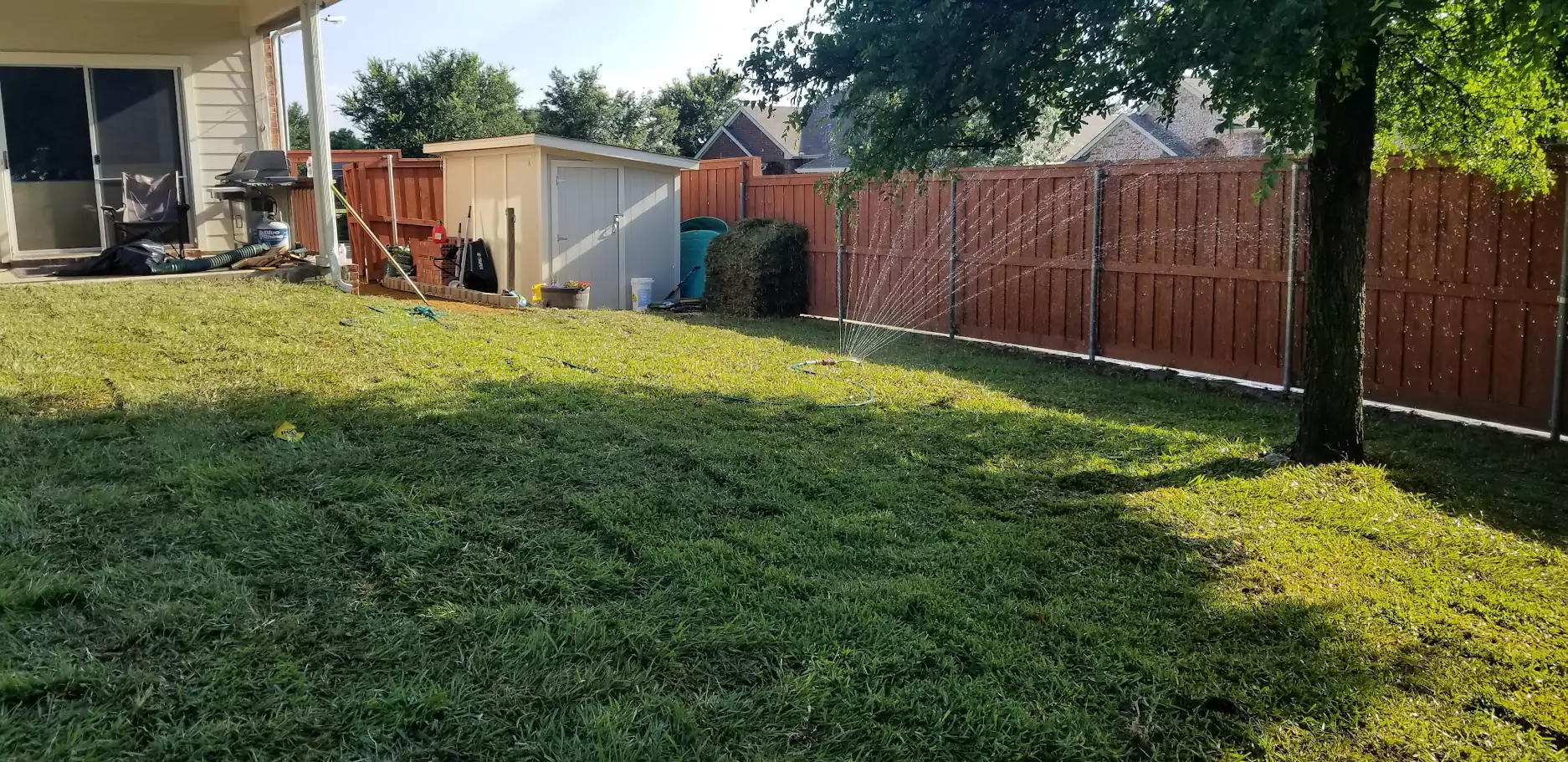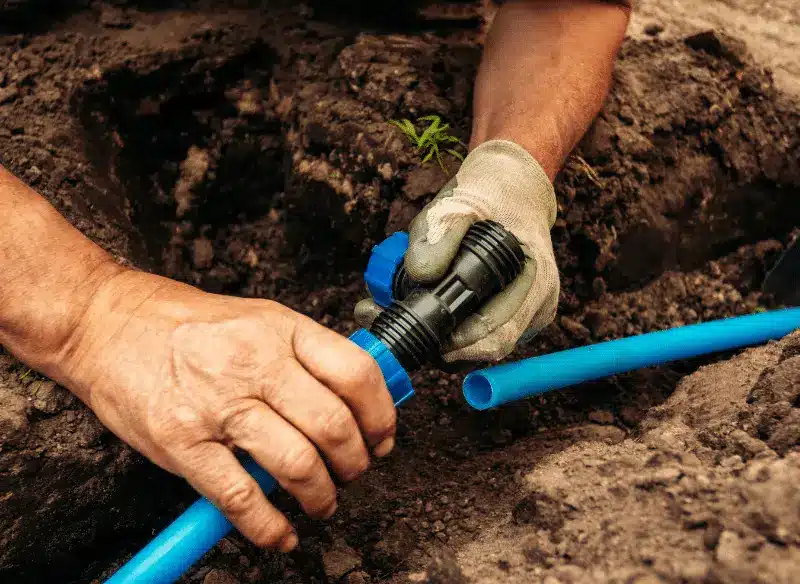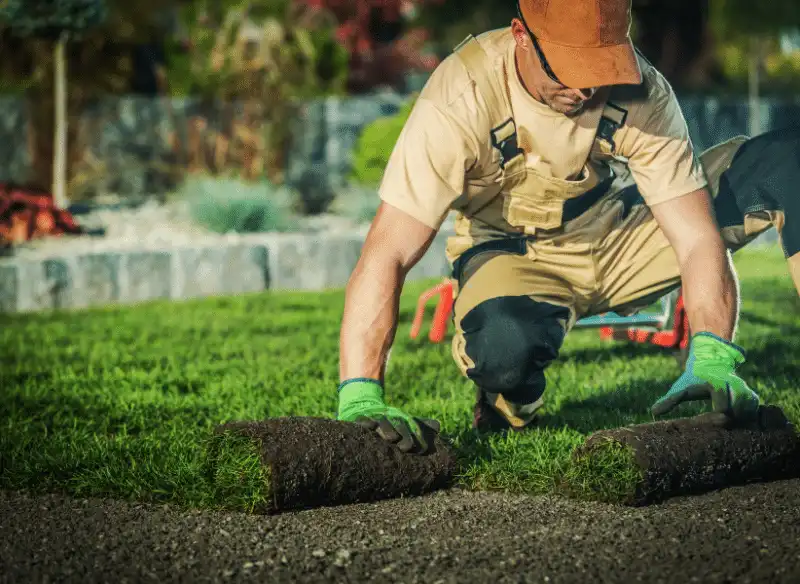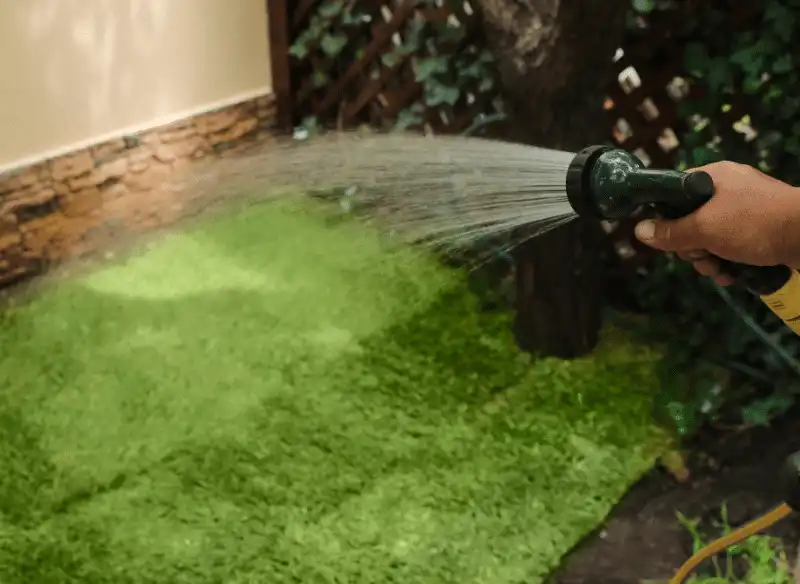On Point Contractors - Post-Installation Sod Care Tips
Initial Watering (First Two Weeks)
Immediately Soak The Sod
Start watering your new sod immediately to prevent it from drying out. Water at least twice daily for the first two weeks (10 to 14 days)
Always Keep Damp
Make sure the newly installed sod is always damp. It should never be soaking wet, soggy, or too dry. DO NOT WATER AT NIGHT.
Start Watering Early In the Morning & Space Out the Run Times
Ideal watering times are early morning (between 4 and 7 am). Aim for about 20-45 minutes TOTAL per zone per day depending on the irrigation system used and time of year. We recommend splitting the watering time into multiple run times. This gives the water time to soak into the soil. Too much watering too fast can cause puddling and runoff. At least two watering times per day are recommended. For example, on a sprinkler system with rotors, we set the start watering time at 4 am and again for 10am. They will run for about 30 -50 minutes each run time. On a sprinkler system with spray heads, we set the start watering time at 4 am and again for 2 pm. They will run for about 10-20 minutes each
Run Rotors Longer Than Spray Heads
TIP: Run rotor zones 3 to 5 times as long as you would spray heads. Contact an irrigation professional if you need assistance figuring out the exact precipitation rate of your sprinklers.
Water More if Needed
Monitor for hot, dry, or windy conditions, which may necessitate additional watering to keep the sod from drying out.
Don’t Over Water
Avoid overwatering sod as it may lead to fungus and/or mold.
Check for Puddles and Muddy Soil Beneath the Sod
If the soil is too wet, the grass roots cannot grow and integrate with the soil beneath it and the roots may start rotting as well. After watering your sod, inspect it, if you see puddles forming or if your sod is “squishy”, it may be getting too much water.
Avoid Watering During Peak Heat Hours
Try to avoid watering during the peak hours of the day as this can lead to losing water to evaporation, but likewise don’t water in the evening as this may cause fungus-related issues.
Monitor Sod to See if It’s Dry
Your lawn will give visual signs when it’s lacking water. If you notice the sod contracting and gaps appearing between the sod pieces, it means the sod is drying out and requires watering. Similarly, if the grass turns gray and stays flattened after stepping on it, it’s a sign that the grass is wilted and needs hydration.
Some Sod Will Turn Brown
Some sod squares will turn brown. Nothing to be alarmed about. They either need more water, or are in shock (this is normal). Be sure they are getting enough water and they should green up.
Watering Schedule Considerations
Factors to consider for the watering schedule: sod type, amount of shade, slope of land, how well water drains through the soil, time of year, heat…
Week Three
Gradually start reducing the watering frequency to water once per day
Week Four
Gradually start reducing the watering frequency to water every other day
After One Month
Water deeply but less frequently, about 1-3 times per week (depending on the season)
Starting from week four onwards, promote the growth of deeper roots by watering less often but for longer durations. The roots will extend deeper as they search for water.
After your sod has taken root, it’s best to water it early in the morning (start around 4 am to 6 am). This timing helps the sod preserve moisture for use during the day since evaporation is minimal at this time. Depending on the soil type, a well-established lawn requires up to 1 inch of moisture per week, which can come from either rainfall or additional watering.
Keep foot traffic to a minimum, if possible none.
Don’t walk on the sod for at least 3 to 4 weeks.
Once you’ve given your lawn its initial watering, it will become quite soft. Avoid walking on it to prevent tearing or damaging your new sod.
Arrange your sprinklers in a way that allows you to move them to new positions using the hose without stepping on the grass.
It’s crucial not to use the lawn, and to keep children and pets off the new sod for at least three to four weeks, or until the sod is firm enough to withstand foot traffic.
The new sod needs to establish a root system and will be delicate until it does. Think of it as a carpet laid over your soil: The roots are striving to penetrate the ground below. Walking on it can cause disturbances and hinder the sod’s ability to settle properly into the soil
Mowing
Wait until the sod is well-rooted, typically 3-4 weeks after installation. Ensure the grass is dry before mowing so you can avoid leaving tire tracks, sinking areas, or indents.
Freshly laid sod is usually ready for mowing once it grows to a height of three to four inches. Different types of grass have varying care and mowing requirements. For instance, Zoysia grows slower than Bermuda and St. Augustine, meaning it doesn’t require mowing as frequently.
General mowing advice for all sod varieties suggests trimming the grass every few weeks as it enters and exits its dormant phase, and weekly during its most vigorous growth period.
We suggest mowing to a height of about 2.5 inches
Mow Bermuda grass weekly during its peak growing season.
Zoysia and St. Augustine can be mowed every couple of weeks because they grow slower than Bermuda. Zoysia can be mowed the least amount because it is the slowest growing of all southern grass types.
Weed Control
There WILL be weeds at some point in your lawn. It is inevitable. It is nothing to be alarmed about though.
The key is at the first sign of weeds protruding, identify them and research how to remove them safely.
Every weed is different and may have different methods of removing it.
Avoid using herbicides if possible until the sod is well established (around 60-90 days).
Hand-pull weeds as soon as you see them during the establishment period to prevent damage from chemical treatments. Make sure to remove and dispose of them in a bag.
Do NOT shake or dispose of weeds over the lawn
Once established, apply a pre-emergent herbicide in early spring and fall to prevent weed germination.
Insect / Pest Control
Grub worms can be a significant problem for any lawn, especially newly installed grass in Dallas, Texas, where the warm climate can be conducive to their proliferation. Addressing grub worms effectively involves both preventive measures and active treatments.
It’s important to confirm the presence of grubs.
Visual Inspection: Check for spongy areas of the lawn where the turf lifts easily from the soil. Peel back sections of turf in different areas, especially where you notice yellowing or browning of the grass. If you see white, C-shaped grubs near the surface, you likely have an infestation.
Counting Grubs: If you find more than five grubs per square foot, treatment is recommended.
Fertilization
We recommend delaying any nutrient applications to your newly sodded lawn for at least 45-90 days. The soil that comes with the sod, as well as the topsoil mixed into the ground, already contains plenty of nutrients. Adding fertilizer before this period may lead to nutrient burn on the grass blades.
Fertilize in early spring and then every 6-8 weeks during the growing season with a balanced fertilizer. Adjust based on specific grass needs:
- Bermuda: Higher nitrogen content.
- Zoysia: Moderate nitrogen.
- St. Augustine: Lower nitrogen to prevent excessive thatch buildup.
General Maintenance:
Monitoring: Regularly check for signs of pests, disease, or drought stress. Treat problems promptly to prevent them from spreading.
Professional Help: Consider hiring a lawn care service for periodic maintenance and specialized treatments.
Top Dressing: Apply a thin layer of compost or topsoil after sod establishment to improve soil health.
Maintain Healthy Soil: Enhance soil health with organic compost and proper aeration. Healthy soil supports beneficial nematodes and other natural predators of grubs.
We recommend using natural and organic treatment options over chemical usage.
If you have any questions or concerns, please feel free to contact us!
Here is the Suggested watering schedule for an established lawn in Dallas Fort Worth Texas:
| Season | Watering Type | Total Run Time | Days / Week |
|---|---|---|---|
| Spring | Sprays | 10 – 15 minutes | 2 – 3 |
| Rotors | 30 – 80 minutes | 2 – 3 | |
| Summer | Sprays | 10 – 15 minutes | 3 |
| Rotors | 30 – 90 minutes | 3 | |
| Fall | Sprays | 15 – 20 minutes | 1 – 2 |
| Rotors | 30 – 80 minutes | 1 – 2 | |
| Winter | Sprays | 10 – 12 minutes | 1 |
| Rotors | 20 – 40 minutes | 1 |
Tip: Split up the total run time into 2 or more run times if you are getting runoff.
Example: instead of running a rotor zone for 50 minutes, run it for 25 minutes, and then run it again later for another 25 minutes.
Disclaimer
The general watering times we provide for established sod are intended as broad guidelines based on typical conditions. However, actual watering needs can vary significantly due to differences in irrigation systems, Water disbursement types (Ex: Rotors vs Sprays vs Drip), soil types, landscaping, and local climate conditions.
We offer these watering recommendations as a general reference. Individual results may vary, and we cannot guarantee the effectiveness of these guidelines for every situation. By following these recommendations, you acknowledge that you do so at your own risk. We are not responsible for any damage or issues that may arise from using this watering schedule.




